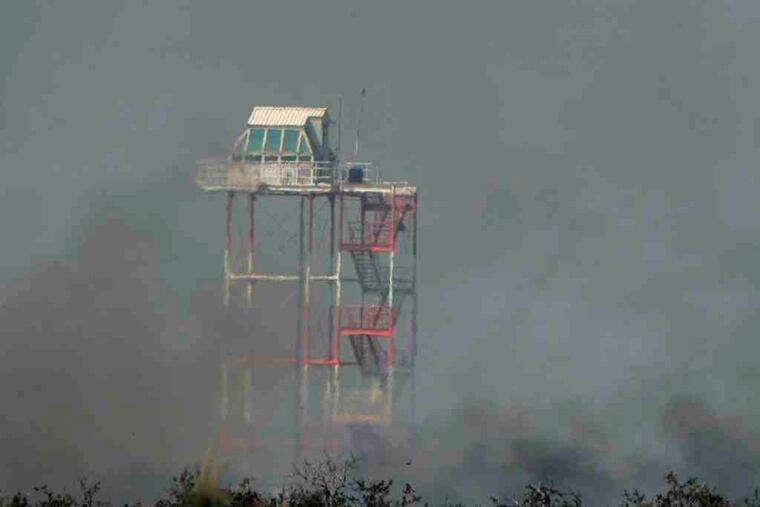In Pines, readying for next big fires
They can't be prevented, but measures taken since the 2007 disaster should help minimize damage to homes.

STAFFORD TOWNSHIP, N.J. - Four years after a forest fire rampaged across southern Ocean County, sending thousands fleeing from their homes, strategic fire breaks are being created in the Pinelands, and communities have stepped up emergency planning for a population that lives in one of the most easily combustible terrains in the country.
"It serves as a wake-up call," said Barnegat Township Police Chief Arthur Drexler. "This was a whole new area for us because of the increase in the population west of the Garden State Parkway."
The fire started about 2:15 p.m. on May 15, 2007, reportedly when an F-16 dropped flares during a low-level pass while on a training mission at the New Jersey Air National Guard's Warren Grove target range. After the fire, the future of the range - situated in Little Egg Harbor and Bass River Townships - was in doubt when Gov. Jon S. Corzine and several legislators sought to shut it down.
Air Force officials worried about losing one of the few air-to-ground training areas on the East Coast. Top Air National Guard officers met with officials from Stafford and Barnegat, and current Stafford Mayor John R. Spodofora, who was on the Township Council at the time, said they reviewed every aspect of the range's operation.
"We developed new restrictions and operational and safety procedures that are now in place for the operation of the range, and the aircraft using the range," Spodofora said.
"Aircraft approaches, flight paths, elimination of the use of flares, proper arming processes of aircraft, better firefighting equipment, new restrictions on when aircraft could use the range based on fire conditions. . . . New processes were established for reporting any potential fires to assure we contain future fires quickly before they spread."
Long-planned fire-break projects are under way in Stafford and Barnegat. Over the last four years, the state Forest Fire Service methodically burned underbrush during controlled conditions, setting up blocks of less-flammable forest to defend against future wildfires.
Work by contractors involves thinning trees alongside several roads to create a defensible zone that firefighters can use to head off an advancing blaze and deprive it of fuel.
An important tool is "prescribed burning," purposely set fires on winter days when the wind is light and the flames stay low on the forest floor, burning dead brush, leaves, and pine needles, but leaving trees unharmed.
The Ocean-Burlington County line, a region marked by cedar swamps and the mysterious pygmy-pine forest known as the Plains, has historically been a tough place to do prescribed fires because the winds are unpredictable.
"The Weather Service will give you a forecast, but when you get out there, the wind is totally different," said Bill Edwards, a district fire warden.
After 2007, thousands of undisturbed acres remained - and the fire service could safely use prescribed burning there for the first time in years, Edwards said.
"We got a lot of burning done all around Stafford Forge Wildlife Management Area, Bass River State Forest, and the range property," Edwards said, calling it "a once-in-a-career opportunity" for wardens to shape the future fire history of the region.
Prescribed burning has created blocks of forest less prone to big wildfires, and can help wardens plan their response to the next emergency. But the process never ends.
Even now, "a lot of that area could re-burn," Edwards said.
Compared with historic fires, the 2007 blaze was only an average event, according to fire experts and Pinelands scientists. Digital analysis of maps and aerial photographs at Rutgers University showed that nearly all of western Stafford burned repeatedly in the 1930s.
But that was before the sharp population growth of the 1990s, when Ocean Acres grew in Stafford and upscale adult communities began building in western Barnegat. The developments hardest hit by the fire were Brighton at Barnegat and Pinewood Estates.
Three homes were destroyed at Brighton. Pinewood Estates had 10 homes damaged and six homes without power, Township Administrator David Breeden said.
One of the biggest issues the township faced was not being able to alert residents of the conditions, Breeden said. Police officers went down each street in the area to tell residents what was going on.
"After the fire, we were able to install a Nixel phone system, which allowed us to send out messages to all of our residents at one time," Drexler said.
Barnegat and Stafford jointly developed a Fire Safety Initiative Plan. A key part of the plan was the creation of a fire break along Pancoast Road and a fire break along the perimeter of Brighton at Barnegat, Pinewood Estates, and Scrubby Pines Camp Ground.
Surrounding municipalities have also informed residents of ways to prevent forest fires.
"We have gone to Brighton at Barnegat and Pinewood Estates and educated them on the importance of clearing the underbrush, so if there is a fire, there is not that much fuel that is available for it," said Kevin Lanahan, chief of the Pinewood Estates Volunteer Company.
Spodofora said the changes will help municipalities deal with forest fires no matter how they start.
"Forest fires are part of the natural ecology in the Pinelands," Spodofora said. They "will happen again, either from a lightning strike or carelessness. However, we are now better prepared to control these fires and reduce the endangerment to people or property."